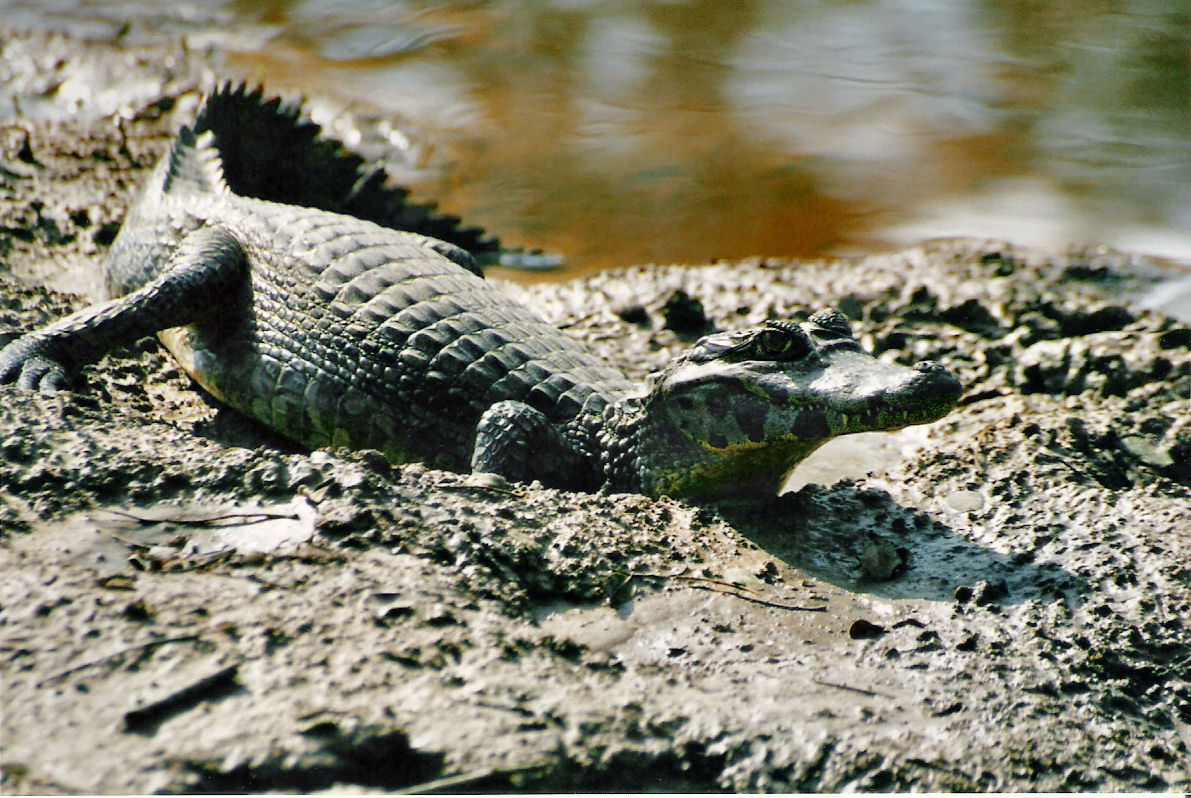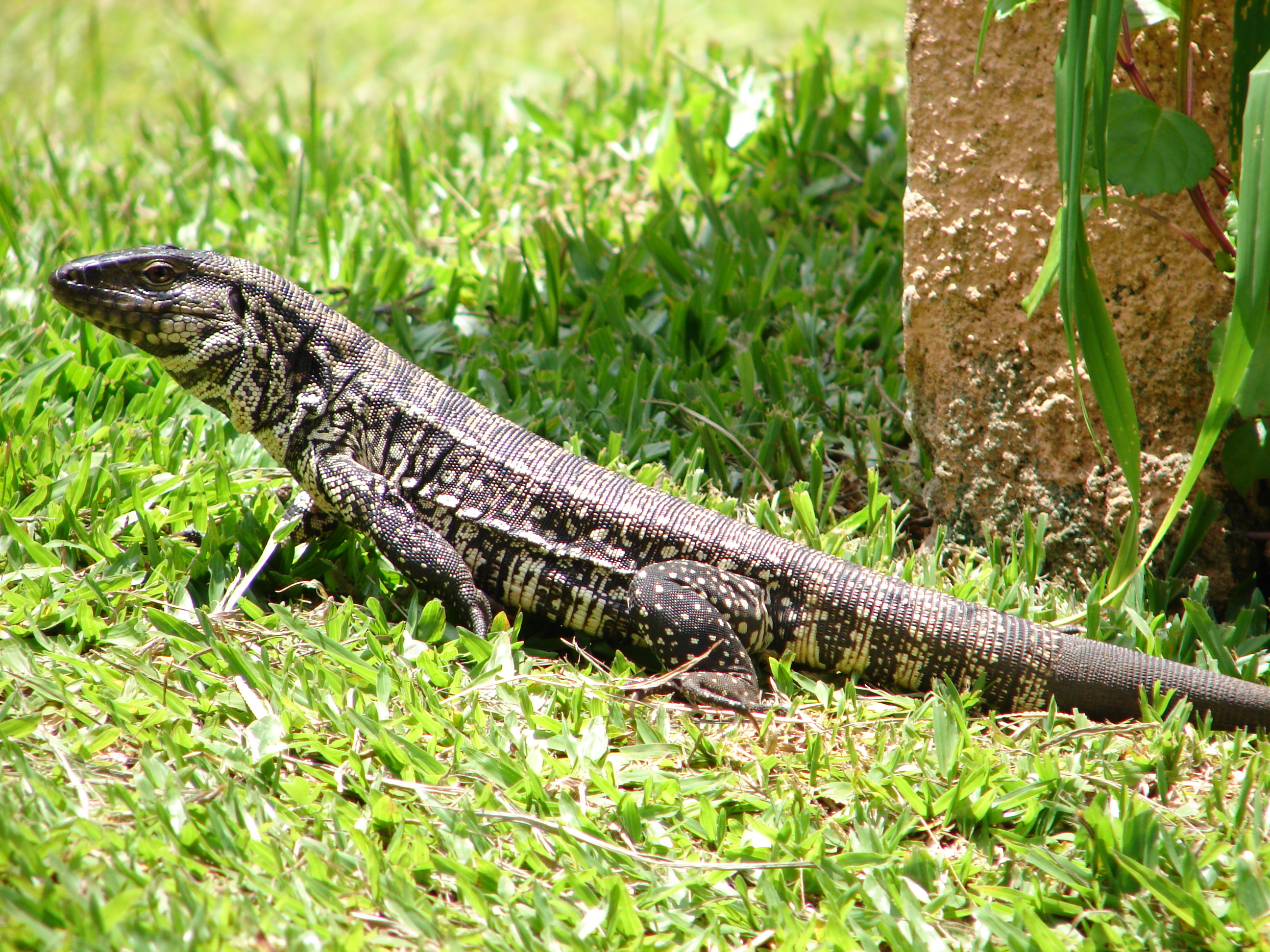|
Caiman Lizard
The genus ''Dracaena'' (romanized form of the Ancient Greek δράκαινα - ''drakaina'', "female dragon"), also called caiman lizards or water tegus, is in the teiid family, along with tegus and ameivas. Caiman lizards are found in South America in Ecuador, Colombia, Paraguay, Peru and Brazil. These semiaquatic lizards spend a lot of time in the water and inhabit marshes, streams and flooded forests. Caiman lizards often bask on branches overhanging the water. Classification Extant Species Listed alphabetically. The Reptile Database Fossils * †'' Paradracaena colombiana'' - the Middle ...[...More Info...] [...Related Items...] OR: [Wikipedia] [Google] [Baidu] |
Caimans
A caiman (also cayman as a variant spelling) is an alligatorid belonging to the subfamily Caimaninae, one of two primary lineages within the Alligatoridae family, the other being alligators. Caimans inhabit Mexico, Central and South America from marshes and swamps to mangrove rivers and lakes. They have scaly skin and live a fairly nocturnal existence. They are relatively small-sized crocodilians with an average maximum weight of depending on species, with the exception of the black caiman (''Melanosuchus niger''), which can grow more than in length and weigh in excess of 1,000 kg (2,200 Ib). The black caiman is the largest caiman species in the world and is found in the slow-moving rivers and lakes that surround the Amazon basin. The smallest species is the Cuvier's dwarf caiman (''Paleosuchus palpebrosus''), which grows to long. There are six different species of caiman found throughout the watery jungle habitats of Central and Southern America. The average length for most o ... [...More Info...] [...Related Items...] OR: [Wikipedia] [Google] [Baidu] |
Brazil
Brazil ( pt, Brasil; ), officially the Federative Republic of Brazil (Portuguese: ), is the largest country in both South America and Latin America. At and with over 217 million people, Brazil is the world's fifth-largest country by area and the seventh most populous. Its capital is Brasília, and its most populous city is São Paulo. The federation is composed of the union of the 26 States of Brazil, states and the Federal District (Brazil), Federal District. It is the largest country to have Portuguese language, Portuguese as an List of territorial entities where Portuguese is an official language, official language and the only one in the Americas; one of the most Multiculturalism, multicultural and ethnically diverse nations, due to over a century of mass Immigration to Brazil, immigration from around the world; and the most populous Catholic Church by country, Roman Catholic-majority country. Bounded by the Atlantic Ocean on the east, Brazil has a Coastline of Brazi ... [...More Info...] [...Related Items...] OR: [Wikipedia] [Google] [Baidu] |
Dracaena (lizard)
The genus ''Dracaena'' (romanized form of the Ancient Greek δράκαινα - ''drakaina'', "female dragon"), also called caiman lizards or water tegus, is in the teiid family, along with tegus and ameivas. Caiman lizards are found in South America in Ecuador, Colombia, Paraguay, Peru and Brazil. These semiaquatic lizards spend a lot of time in the water and inhabit marshes, streams and flooded forests. Caiman lizards often bask on branches overhanging the water. Classification Extant Species Listed alphabetically. The Reptile Database Fossils * †'' Paradracaena colombiana'' - the Middle ...[...More Info...] [...Related Items...] OR: [Wikipedia] [Google] [Baidu] |
Smithsonian Institution
The Smithsonian Institution ( ), or simply the Smithsonian, is a group of museums and education and research centers, the largest such complex in the world, created by the U.S. government "for the increase and diffusion of knowledge". Founded on August 10, 1846, it operates as a trust instrumentality and is not formally a part of any of the three branches of the federal government. The institution is named after its founding donor, British scientist James Smithson. It was originally organized as the United States National Museum, but that name ceased to exist administratively in 1967. Called "the nation's attic" for its eclectic holdings of 154 million items, the institution's 19 museums, 21 libraries, nine research centers, and zoo include historical and architectural landmarks, mostly located in the District of Columbia. Additional facilities are located in Maryland, New York, and Virginia. More than 200 institutions and museums in 45 states,States without Smithsonian ... [...More Info...] [...Related Items...] OR: [Wikipedia] [Google] [Baidu] |
Caiman Lizard
The genus ''Dracaena'' (romanized form of the Ancient Greek δράκαινα - ''drakaina'', "female dragon"), also called caiman lizards or water tegus, is in the teiid family, along with tegus and ameivas. Caiman lizards are found in South America in Ecuador, Colombia, Paraguay, Peru and Brazil. These semiaquatic lizards spend a lot of time in the water and inhabit marshes, streams and flooded forests. Caiman lizards often bask on branches overhanging the water. Classification Extant Species Listed alphabetically. The Reptile Database Fossils * †'' Paradracaena colombiana'' - the Middle ...[...More Info...] [...Related Items...] OR: [Wikipedia] [Google] [Baidu] |
Yacare Caiman
The yacare caiman (''Caiman yacare''), also known commonly as the jacare caiman, Spanish yacaré, Paraguayan caiman, piranha caiman, red caiman, southern spectacled caiman, ''jacaré'' in Portuguese, and îakaré in Old Tupi, is a species of caiman, a crocodilian in the family Alligatoridae. The species is endemic to Argentina, Bolivia, Brazil, and Paraguay. Brown in color and covered with dark blotches, males grow to a total length (including tail) of and weigh around ; while females grow to long and about . Typical habitats of this caiman include lakes, rivers, and wetlands. Its diet primarily consists of aquatic animals, such as snails, and occasionally land vertebrates. Mating occurs in the rainy season and eggs hatch in March, with young fending for themselves as soon as they hatch. The yacare caiman was hunted heavily for its skin to use for leather in the 1980s, which caused its population to decrease significantly. However, trading restrictions placed since have caused i ... [...More Info...] [...Related Items...] OR: [Wikipedia] [Google] [Baidu] |
Tegu
Tegu is a common name of a number of species of lizards that belong to the families Teiidae and Gymnophthalmidae. Tegus are native to Central and South America. They occupy a variety of habitats and are known for their large size and predatory habits. Description Tegus are usually mainly black and some have yellow, reddish or white bands along their backs. Others have lines going down their bodies and unique markings along their top. Their body shape is aerodynamic with long tails and strong legs. Most tegus grow to about a metre long but the black and white tegu (''T. Merianae'') can grow to about 1.3 metres. Tegus use their tongues and vomeronasal organ to find chemical cues associated with their prey and other lizards. A vomeronasal organ is an organ of chemoreception located in the main nasal chamber. Tegus can survive in rainforests, savannas, swamps, meadows, and open fields. Tegus are omnivores and eats seeds, berries, fruits, small rodents, insects, eggs, amphibians, ... [...More Info...] [...Related Items...] OR: [Wikipedia] [Google] [Baidu] |
Young Caiman Lizard
Young may refer to: * Offspring, the product of reproduction of a new organism produced by one or more parents * Youth, the time of life when one is young, often meaning the time between childhood and adulthood Music * The Young, an American rock band * ''Young'', an EP by Charlotte Lawrence, 2018 Songs * "Young" (Baekhyun and Loco song), 2018 * "Young" (The Chainsmokers song), 2017 * "Young" (Hollywood Undead song), 2009 * "Young" (Kenny Chesney song), 2002 * "Young" (Place on Earth song), 2018 * "Young" (Tulisa song), 2012 * "Young", by Ella Henderson, 2019 * "Young", by Lil Wayne from '' Dedication 6'', 2017 * "Young", by Nickel Creek from ''This Side'', 2002 * "Young", by Sam Smith from '' Love Goes'', 2020 * "Young", by Silkworm from '' Italian Platinum'', 2002 * "Young", by Vallis Alps, 2015 * "Young", by Pixey, 2016 People Surname * Young (surname) Given name * Young (Korean name), Korean unisex given name and name element * Young Boozer (born 1948), American ba ... [...More Info...] [...Related Items...] OR: [Wikipedia] [Google] [Baidu] |
GBIF
The Global Biodiversity Information Facility (GBIF) is an international organisation that focuses on making scientific data on biodiversity available via the Internet using web services. The data are provided by many institutions from around the world; GBIF's information architecture makes these data accessible and searchable through a single portal. Data available through the GBIF portal are primarily distribution data on plants, animals, fungi, and microbes for the world, and scientific names data. The mission of the GBIF is to facilitate free and open access to biodiversity data worldwide to underpin sustainable development. Priorities, with an emphasis on promoting participation and working through partners, include mobilising biodiversity data, developing protocols and standards to ensure scientific integrity and interoperability, building an informatics architecture to allow the interlinking of diverse data types from disparate sources, promoting capacity building and catal ... [...More Info...] [...Related Items...] OR: [Wikipedia] [Google] [Baidu] |
Honda Group, Colombia
The Honda Group ( es, Grupo Honda, Tsh, Ngh) is a geological group of the Upper and Middle Magdalena Basins and the adjacent Central and Eastern Ranges of the Colombian Andes. The group, in older literature also defined as formation, is in its present-day type section in the Tatacoa Desert in the department of Huila subdivided into two main formations; La Victoria and Villavieja. The group was originally defined in and named after Honda, Tolima, but has been redefined based on the many fossil finds in the Tatacoa Desert, to the south. In the original type section of its occurrence, the thick group is subdivided into three formations, from old to young; Cambrás, San Antonio and Los Limones. The group dates to the Neogene period; in its broadest definition from the Late Oligocene to Late Miocene, and in the redefined type section restricted to the Laventan age of the South American Land Mammal Ages (SALMA), equivalent to the Middle Miocene Serravallian epoch. The Honda Gr ... [...More Info...] [...Related Items...] OR: [Wikipedia] [Google] [Baidu] |
Laventan
The Laventan ( es, Laventense) age is a period of geologic time (13.8 to 11.8 Ma) within the Middle Miocene epoch of the Neogene, used more specifically within the SALMA classification in South America. It follows the Colloncuran and precedes the Mayoan age.Madden et al., 1997 Etymology The age is named after the Miocene Lagerstätte La Venta, where a rich biodiversity from the Middle Miocene has been recovered from the Honda Group. Formations Fossil content Correlations The Laventan (13.8 to 11.8 Ma) correlates with: * NALMA ** latest Barstovian (15.97-13.65 Ma)Barstovian at Fossilworks.org ** early |
Paraguay Caiman Lizard (Dracaena Paraguayensis) (48434599422)
Paraguay (; ), officially the Republic of Paraguay ( es, República del Paraguay, links=no; gn, Tavakuairetã Paraguái, links=si), is a landlocked country in South America. It is bordered by Argentina to the south and southwest, Brazil to the east and northeast, and Bolivia to the northwest. It has a population of seven million, nearly three million of whom live in the capital and largest city of Asunción, and its surrounding metro. Although one of only two landlocked countries in South America (Bolivia is the other), Paraguay has ports on the Paraguay and Paraná rivers that give exit to the Atlantic Ocean, through the Paraná-Paraguay Waterway. Spanish conquistadores arrived in 1524, and in 1537, they established the city of Asunción, the first capital of the Governorate of the Río de la Plata. During the 17th century, Paraguay was the center of Jesuit missions, where the native Guaraní people were converted to Christianity and introduced to European culture. After ... [...More Info...] [...Related Items...] OR: [Wikipedia] [Google] [Baidu] |
.jpg)



